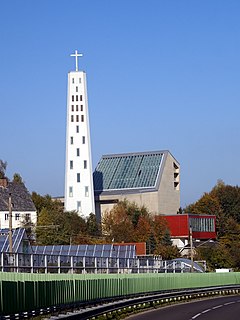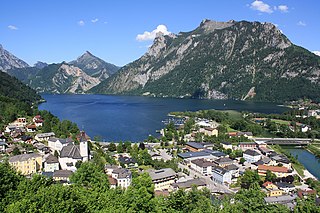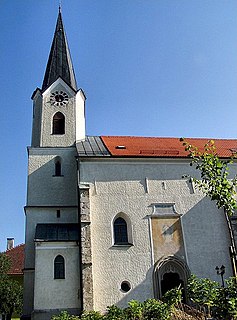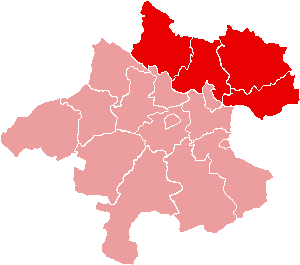See also
| This disambiguation page lists articles associated with the title Mauthausen. If an internal link led you here, you may wish to change the link to point directly to the intended article. |
Mauthausen may refer to:
| This disambiguation page lists articles associated with the title Mauthausen. If an internal link led you here, you may wish to change the link to point directly to the intended article. |

Mauthausen is a small market town in the Austrian state of Upper Austria. It is located at about 20 kilometres east of the city of Linz. The town lies on the banks of the Danube river, opposite the town of Enns, where the major Danube tributary of Enns joins it.

Mauthausen was a Nazi concentration camp on a hill above the market town of Mauthausen, Upper Austria. It was the main camp of a group with nearly 100 further subcamps located throughout Austria and southern Germany. The three Gusen concentration camps in and around the village of St Georgen/Gusen, just a few kilometres from Mauthausen, held a significant proportion of prisoners within the camp complex, at times exceeding the number of prisoners at the Mauthausen main camp.

Lenzing is a small town of approximately 5,000 residents, three kilometers north of Lake Attersee in Austria, It is located in the Upper Austrian part of the Salzkammergut.

German Earth and Stone Works, was an SS-owned company created to procure and manufacture building materials for state construction projects in Nazi Germany. DEST was a subsidiary company of Amtsgruppe W of SS Main Economic and Administrative Office (WVHA). Both Amt. W and the WVHA were headed by Waffen-SS generals Oswald Pohl and Georg Lörner.
Franz Xaver Ziereis was the commandant of the Mauthausen concentration camp from 1939 until the camp was liberated by the American forces in 1945.

Ebensee is a market town in the Traunviertel region of the Austrian state of Upper Austria, located within the Salzkammergut Mountains at the southern end of the Traunsee. The regional capital Linz lies approximately 90 km (56 mi) to the north, nearest towns are Gmunden and Bad Ischl. The municipality also comprises the Katastralgemeinden of Langwies, Oberlangbath, Rindbach, Kohlstatt and Roith.

August Eigruber was an Austrian-born Nazi Gauleiter of Reichsgau Oberdonau and Landeshauptmann of Upper Austria. He was convicted of crimes against humanity at Mauthausen-Gusen concentration camp and hanged.

Gunskirchen is a town in the Austrian state of Upper Austria.

Sankt Lambrecht is a market town in the district of Murau in Styria, Austria. It is known for St. Lambrecht's Abbey, one of the most important Benedictine monasteries in Austria. The monastery complex and its gardens are part of the Zirbitzkogel-Grebenzen nature park.

Sankt Georgen an der Gusen is a small market town in Upper Austria, Austria, between the municipalities of Luftenberg and Langenstein. As of 2015, the town had 3,779 inhabitants.

The Mühlviertel is an Austrian region belonging to the state of Upper Austria: it is one of four "quarters" of Upper Austria, the others being Hausruckviertel, Traunviertel, and Innviertel. It is named after the three rivers Große Mühl,Kleine Mühl, and Steinerne Mühl.
Bretstein was a subcamp of Mauthausen concentration camp located in Bretstein was associated with the SS-owned operation Deutsche Versuchsanstalt für Ernährung und Verpflegung GmbH, which administrated three working farms in Bretstein since 1939. Concerning this regard it was the basic aim to investigate different methods of operations for agriculture, which should have been used for the purpose of the so-called Germanisierung in Eastern Europe.

Hinterbrühl is a town in the district of Mödling in the Austrian state of Lower Austria. It is home to the Seegrotte, a system of caves including Europe's largest underground lake. During World War II, a satellite camp of Mauthausen concentration camp was opened inside the caverns, producing parts for the He 162 jet fighter.
The Steyr-Münichholz concentration camp was one in a number of subcamps of the Mauthausen-Gusen concentration camp in Upper Austria. Inmates were drawn from the main camp, in order to exploit their labor for producing arms in Steyr-Daimler-Puch corporation factories, and to build air-raid bunkers in the town of Steyr.
The Austrian SS was that portion of the Schutzstaffel (SS) membership from Austria. The term and title was used unofficially. They were never officially recognized as a separate branch of the SS. Austrian SS members were seen as regular personnel and they served in every branch of the SS.

The Reichsgau Upper Danube was an administrative division of Nazi Germany, created after the Anschluss in 1938 and dissolved in 1945. It consisted of what is today Upper Austria, parts of Southern Bohemia, and a small part of the Salzkammergut which was annexed from Styria.
Rudolf Anton Haunschmied is an Austrian author and local historian.
The Austrian Mauthausen Committee is responsible for scientific and educational work concerning the Mauthausen-Gusen concentration camp and its satellite camps in Austria. This association was founded in 1997 and is the subsequent organisation of the Austrian Concentration Camp Community Mauthausen.

Gusen was a subcamp of Mauthausen concentration camp operated by the SS between the villages of Sankt Georgen an der Gusen and Langestein in the Reichsgau Ostmark. Primarily populated by Polish prisoners, there were also large numbers of Spanish Republicans, Soviet citizens, and Italians. Initially, prisoners worked in nearby quarries, producing granite which was sold by the SS company DEST.